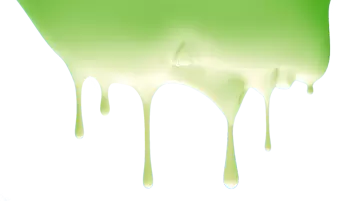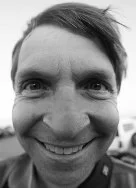 Consider perspective distortion when examining pictures for ghosts...
Consider perspective distortion when examining pictures for ghosts...
When viewing possible pictures of ghosts, we feel it necessary to make you, the reader, aware of a photographic phenomenon commonly known as "perspective distortion." (Photo example shown here: A man's nose appears to be larger than normal due to distortion.)
What is Persective Distortion?
Perspective distortion is a common effect caused by the lens of the camera, especially when using a wide angle camera lens. Objects in photos can become ballooned or warped, making them appear different from how they should look normally. Perspective distortion is especially noticeable when objects are photographed close to the lens, though the distortion can be subtle and not recognized by the untrained eye. The distortion is directly related to the focal length, consistently increasing relative to how close the subject is to the lens. Distance minimizes the effect. Items in the photo will bend away from the center of the frame, creating one part to appear larger (or closer to the viewer) than the rest of the subject matter.
Perspective distortion can also be found in cinematography, specifically used in horror films or scenes that are meant to induce fright. In one small example, the Twilight series of movies use this effect quite a bit to present weird-looking camera angles that creates an eerie world for vampires and werewolves to inhabit. Distortion of the subject matter is a popular movie effect that is used for artistic purposes, changing how we view the scene. I can't help but recall Jack Nicholsen's odd head popping through the door in The Shining and saying, "Here's Johnny!"
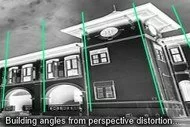 How Does Perspective Distortion Relate to Ghost Pictures?
How Does Perspective Distortion Relate to Ghost Pictures?
When examining ghost pictures, we can take account of the distortion if we know to look for it. How distorted is the ghost within the photo in comparison with the rest of the picture? Is the perspective distortion the same throughout the image? A common mistake by people who fake ghost pictures is that they do not know to account for this phenomenon. If you know to look for this, oftentimes false specters will easily be spotted as not part of the original image. Look for this when examining ghost pictures, even those on this website. Become a good detective and study the light, shadows, and colors. Pay attention to the angles and the perspective. Does everything line-up accordingly?
Deformities in Photographs
Perspective distortion can also deform images of people or things in the frame. A tree, for example, might become warped enough to take on a human form, becoming a ghost. A man standing to the left in a photo might now appear to have an elongated jaw like an animal, etc. Tkay of Paranormal Sight has taken note of this while examining ghost pictures. She has seen objects in photographs (especially things off in the distance) that are bent towards one another due to distortion. The human brain does not easily recognize the objects for what they are, and thus, works to view them as something identifiable to itself. The mind wants to believe it is seeing something human. In example, two poles might angle toward one another in the photograph. To the brain, they no longer look like poles but appear to be large, human-looking legs! Perspective distortion can add to this effect called anthropomorphizing.
Although perspective distortion is something to look for, there are other types of distortion found with perspective. Horizontal and vertical linear perspectives create strong angles that head east and west or north and south, respectively. Different perspectives certainly come into play with how we view subject matter in our photographs, especially when looking for ghosts.
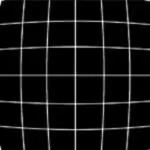
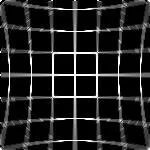 (Photo examples of distortion: Two types of distortion shown with grids. The first (left) photo shows the more common 'barrel distortion,' and at right of it, a second photo shows what is known as 'pincushion distortion.')
(Photo examples of distortion: Two types of distortion shown with grids. The first (left) photo shows the more common 'barrel distortion,' and at right of it, a second photo shows what is known as 'pincushion distortion.')
Note: Angels & Ghosts wishes to thank Tkay for suggesting the idea behind this article.

